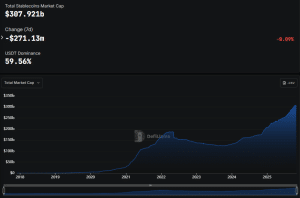Stablecoin Rules Clarified as ASIC Defines New Crypto Guidelines: Report

- ASIC classifies stablecoins and tokenized assets as financial products under its regulation.
- Service providers must secure AFS licenses, with an eight-month transition to comply.
- New rules aim to protect investors while supporting innovation in Australia’s crypto market.
The financial regulator in Australia has made a historic step to regulate the digital asset market. The Australian Securities and Investment Commission (ASIC) has regarded stablecoins, wrapped tokens, tokenized securities and digital wallets as a financial product in its jurisdiction. Recent developments Service providers must now become licensed as the AFS licensee. The transition period is 8 months.
The new guidance was issued by ASIC on Wednesday. It preconditioned a no-action stand that will be until June 30, 2026. The set decision gives service providers room to comply and little market change should be anticipated.
Tokenization and DLT were described by ASIC Commissioner Alan Kirkland as groundbreaking developments to the finance markets of the world. The transition is meant to give a regulatory guideline of the innovation performed within the confines of the regulatory guardrails.
New Guidance Defines Tokenized Assets
Amendment of information sheet 225 helps to clarify how information product categories apply and do not apply to digital assets. It demonstrates that many of the traded tokens reach the necessary level already.
The update of the regulator is compatible with the general-based reforms of the government regulating digital assets. Under this new strategy, companies will be forced to meet the licence conditions that will aim at protecting the consumer interests, as well as guaranteeing integrity in the market.
Also Read: ASIC Bans Financial Adviser Over $14.8M Crypto Scam Fraud
In a case where ASIC is considering past action, it might be supposed to look with regard to the present no-action stance. It would, nevertheless, take up cases involving high-value injuries or systemic misuses. Another possible use is the expansion of its omnibus account structure to blockchain-related assets by the overseer. Custody rule changes will be done to suit holdings in DLT.

This recommendation is in addition to a larger study program that it is undertaken through the Reserve Bank of Australia Project Acacia. The project delves into tokenized asset wholesale markets and how they could be introduced into the mainstream financial systems. The strategy implemented by ASIC is a viable aid that also keeps alive the expectations of compliance by the participants in market digital assets.
New Laws Strengthen Oversight of Stablecoin Providers
The Treasury of Australia has introduced the accompanying bills in order to support these reforms. In September a draft law, which gives penalties of up to 10% of annual turnover on breaches was published.
Exchanges and operators will be obliged to have the AFS liches or face fines as much as A$16.5 million. Additional financial fines might be provided in case of false and misleading behaviors, as well as unfair conditions of contracts.
Smoother digital platforms will play fewer obligations to adhere to. Individuals who treat A $5,000 of a client or less and administer less than A $10 million of yearly funds are not subject to comprehensive licence.
It is a progressive regulation and commercial allowability method. According to Treasury officials, the framework will increase consumer protection provided by the Corporations Act.
In September, ASIC gave relief of the classes to intermediaries that distribute stable coins issued by licensed organizations. Exemption on the need to acquire market and clearing license is given until June 2028.
The AUDM stablecoin of Catena Digital is the pioneer approved issuer on AUDM. ASIC will continue to introduce more issuers once further discussions with industry on the changes.
Also Read: ASIC Eases Stablecoin Distribution with Licensing Relief Until 2028: Report
You May Also Like

Kalshi debuts ecosystem hub with Solana and Base

Coinbase Says Banks’ Stablecoin Fears ‘Ignore Reality,’ Dismisses Deposit Drain Concerns
